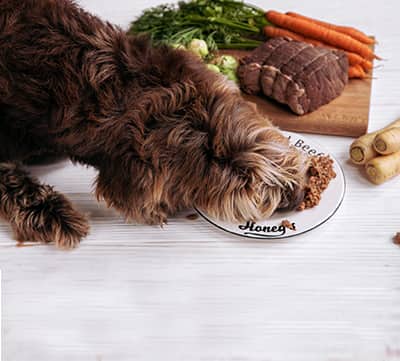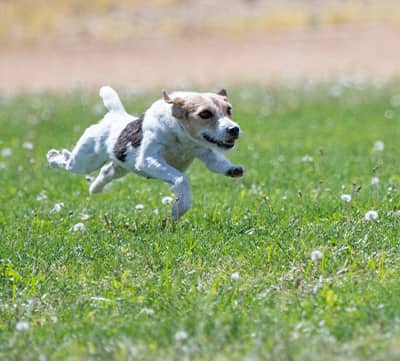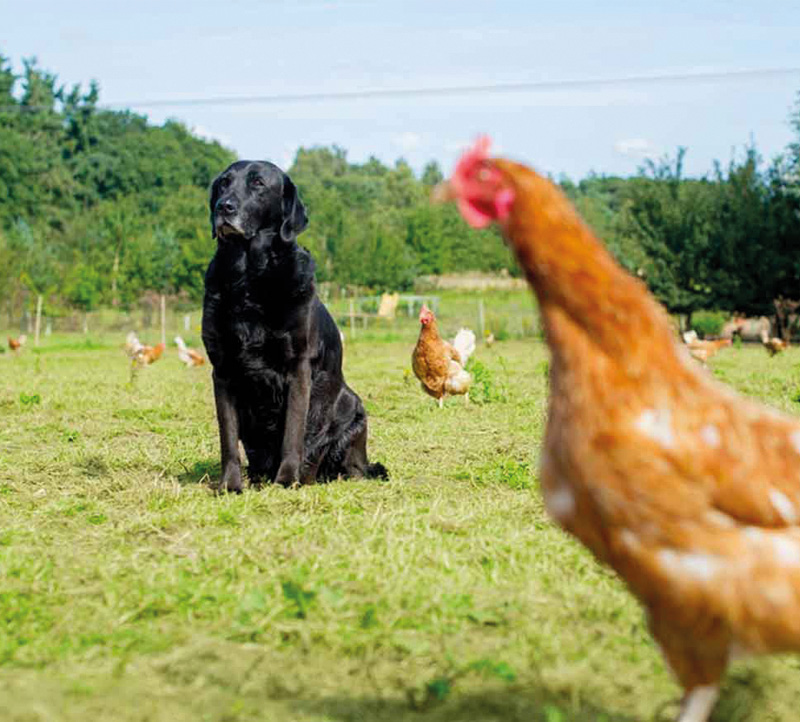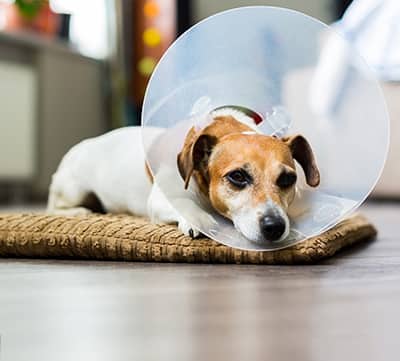Raw feeding and different health conditions in dogs
Quick links to specific conditions covered in this article:
- Gingivitis
- Halitosis (bad breath)
- Arthritis
- Cancers and tumours
- Discospondylitis
- Elbow dysplasia
- Epilepsy
- Hip dysplasia
- Lafora disease
- Luxating patella
- Osteochondritis dissecans
- Spondylosis
- Von Willebrand disease
- A word about steroids
Mostly raw
With one or two exceptions (primarily where the dog’s immune system has been compromised), you will see that a raw food diet is always recommended. This is because raw food is the easiest thing for your dog to digest and supports his or her immune system. Where raw feeding isn’t recommended, you should not revert to processed food but simply cook the ingredients in the way prescribed. Processed food is an underlying cause for as many as 9 out of 10 visits to the vet, and this includes expensive, so-called scientifically developed, brands.
A reminder about water
Water is treated with a great number of chemicals. Ill dogs are less tolerant of these chemicals, and so it is advisable to find a source of pure, clean water. This could be a mineral water (better from a glass bottle than plastic as plastic bottles left in the sun alter the chemical composition of their contents), rainwater or filtered water.
Why ill dogs do better on organic food
Intensively reared meat and intensively farmed vegetables, especially those imported from outside Europe, are often grown without the regulatory framework we are used to, and may contain a surprisingly high percentage of unnatural chemicals (everything from growth hormones to nitrates and from steroids to pesticides). Furthermore, meat will include the residue of whatever the animal has been fed. This is particularly relevant in the case of grain-fed livestock and poultry, and grain is especially harmful to dogs. It is better, therefore, to feed organic food to ill dogs.
Free dietary advice
If you need dietary advice, don’t forget it is available, free of charge and without obligation.
Gingivitis
Gingivitis is an infection of the gums and is often caused by the build-up of plaque on the teeth. Symptoms include bad breath, a sore mouth and consequent loss of appetite. Prevention is better than cure and chewing regularly on bones is to be recommended. There is a close connection between oral health and general health. There is every reason, therefore, to feed a raw diet.
Halitosis (bad breath)
The most common cause of bad breath is poor diet or poor oral health. The latter could be caused by bacteria, saliva and food particles forming plaque. A worse problem is periodontal disease, which can lead to gingivitis. Other possible causes include diabetes, kidney disease, gastrointestinal disease and infections in the area around the mouth. Respiratory diseases (for instance a sinus infection) and other oral diseases may be responsible.
Finally, one should not rule out something that the dog is eating, such as household waste (or worse!). Obviously, the treatment will depend on the cause. Good dental hygiene can be achieved by chewing regularly on bones. As with gingivitis, there is a close connection between oral health and general health, and there is every reason, therefore, to feed a raw diet.
Arthritis
Depending upon whom you talk to, the terms ‘arthritis’, ‘osteoarthritis’ and ‘degenerative joint disease’ may or may not be used to describe the same thing. Degenerative joint disease is characterised by the loss of the smooth cartilage that covers and protects the ends of the bones in a movable joint.
The cartilage has no nerves so when it touches the cartilage of another bone there is no pain. When the cartilage wears away, the bone is exposed and, since bones do have nerves, pain and inflammation are caused by the two ends in a joint touching each other. This is the sign that arthritis is present and will probably be progressive.
In degenerative joint disease, small bony projections known as osteophytes form on the bone that is closest to the joint. Degenerative joint disease can occur as a result of wear and tear on an otherwise normal joint and occurs as the dog ages.
Osteoarthritis may also occur as a result of hip dysplasia or elbow dysplasia.
A raw food diet helps arthritis because it is low in carbohydrates. High-carbohydrate diets create an excessively acid bloodstream, decreasing uric acid solubility, which in turn leads to joint pain.
Bones are an important part of the diet and should include joint bones for their cartilage content (high in chondroitin sulphate) and the marrow of bones including chicken (chicken bones have lots of glucosamine). Turkey is also a good source and, importantly, much lower in salt than most commercial supplements. Such a diet often does away with the need for such supplements as glucosamine and chondroitin, or lowers the required dose.
Supplements that help arthritic pets include cod liver, evening primrose and star flower oil, vitamin C, green-lipped mussel, turmeric, ginger and boswellia (between 1/16th and 1/8th of a teaspoon only), black treacle (also known as blackstrap molasses) and the herbs devil’s and cat’s claw.
Cancers and tumours
One of the ways in which many cancers and tumours can be starved is to reduce the carbohydrates in the diet to 20% or under. (Bear in mind that many commercial dog foods may contain 60% or more carbohydrates.) The purity of the food – ideally it should be organic – and the water is crucial.
Vegetables should be as fresh as possible as after a few days vegetables start to lose their nutritional value. Of the many different supplements that can help cancer patients, vitamin C is perhaps the most important: 1000mg a day (or more) is recommended. Please contact Honey’s Real Dog Food if you would like more specific advice.
Discospondylitis
Discospondylitis (diskospondylitis or vertebral osteomyelitis) is a bacterial or fungal infection of the vertebrae and the intervertebral discs. The resulting inflammation and swelling along with the bone deformities put pressure on the spinal cord, which runs through the vertebrae. Feed the dog a natural diet. Supplements to consider include vitamin C and zinc. Give the dog a natural probiotic.
Elbow dysplasia
Elbow dysplasia is more common in fast-growing larger-breed dogs while they are still puppies. Dogs with elbow dysplasia usually have a limp and may hold the leg out from the body when walking. Some will avoid putting any weight on the leg at all.
As many sufferers mature, the symptoms may become less severe. Medication may be needed to reduce pain. Some dogs may need surgery and others will have an altered elbow joint with arthritis from a young age.
Feed a raw food diet with plenty of bone such as chicken wings, chicken thighs, drumsticks, pork ribs and marrow bones. Supplement with oil (fish, evening primrose or hemp oil) and vitamin C. Do not allow the dog to over-exercise.
Epilepsy
Epilepsy is a disorder of recurring seizures. Epileptic fits are the result of a sort of short-circuiting of the nerves in the brain, so that many nerves are stimulated at once. This can result in quite violent body spasms. Not all dogs that have seizures are epileptic; fits can happen for a number of reasons.
For example, older dogs may have an underlying heart, kidney or liver condition, or there may be a tumour on the brain. This last possibility is, thankfully, not all that common. Traumatic injuries to the head can lead to fits in any age dog, as can infections, such as viral or bacterial ones.
Occasionally, poisons, such as slug pellets (metaldehyde), will cause a dog to fit. In any of the above cases it is important to treat the underlying problem, if possible, and so eliminate or control the fits that way.
Diet has an important role to play in the treatment of epilepsy. Meats low in glutamate, such as lamb, are best. Avoid meat from animals that have been fed a grain diet. Avoid rabbit, turkey and oily fish, as all are high in glutamate.
Epilepsy is definitely on the rise and the combination of wheat and soy in pet foods may well be responsible. Eggs (again low in glutamate) are a good source of nutrition. In addition to the above, one should try to ensure the diet is free of chemicals (preservatives, taste enhancers, palatability factors, chemical antioxidants and so forth), making organic ingredients ideal.
Processed foods are particularly bad for epileptic dogs as they are high in grain and incorporate rancid fats.
Hip dysplasia
Hip dysplasia is associated with abnormal joint structure and a laxity in the muscles, connective tissue and ligaments that normally support the joint. As the laxity develops, the head of the femur and socket joint separate. This is known as subluxation.
Most dogs are born with normal hips; however, owing to their genetic makeup and possibly other factors, the soft tissues surrounding the joint develop abnormally, causing subluxation that leads to altered gait and/or lameness.
One or both hips may be affected. Feed a raw food diet with plenty of bone such as chicken wings, chicken thighs, drumsticks, pork ribs and marrow bones. Supplement with oil (fish, evening primrose or hemp oil) and vitamin C.
Do not allow the dog to over-exercise.
Lafora disease
Lafora disease (sometimes called Lafora progressive myoclonic epilepsy) is an inherited form of epilepsy that can occur spontaneously in any breed of dog, but it particularly affects the Miniature Wire-haired Dachshund, Basset Hound and Beagle.
There is a website (laforadogs.org) which is asking for testing to be done for the breeds at risk so that dogs who are carriers are no longer used for breeding. The same dietary advice as for epilepsy (see above) is recommended.
Luxating patella
Luxating patella only occurs in certain breeds, particularly small dogs with short legs, and describes a process whereby one leg bone jumps out of its socket.
When it occurs, the leg locks up with the foot held off the ground. It cannot return to its normal position until the quadriceps muscle relaxes and increases in length.
Typically, a small dog will be running and then in mid-stride yelp, hold up the back leg and then continue as if nothing is wrong.
After a time, the leg drops back down and is used normally. The lameness is very intermittent and does not seem to worry the dog. A raw food diet is excellent. Ensure plenty of bone. Keep the dog from becoming overweight as this will worsen the symptoms.
Osteochondritis dissecans
Osteochondritis dissecans, or OCD (not obsessive–compulsive disorder!), is a disease of the cartilage which may affect the shoulder, elbow, knee or hock. Some dogs will barely have a limp, while others may not want to put any weight on the affected leg.
Lameness can worsen after exercise and improves after resting.
It is caused by many factors, including genetics, trauma, rapid growth and poor nutrition. The conventional treatment is strict rest, an NSAID (non-steroidal anti-inflammatory drug) such as carprofen or surgery to remove the damaged cartilage.
It is important that the dog does not become overweight. Feed a raw food diet. Ensure plenty of bone. Supplements which may help include oil (fish, evening primrose, starflower and/or hemp) and vitamin C.
Spondylosis
Spondylosis is a non-infectious fusion or degeneration of the vertebrae. The dog is stiff after getting up, appears to be limping (especially after exercise) or begins snapping or licking the lower back. Occasionally, a bony spur or fusing of the vertebrae will cause loss of bladder control and the dog will become incontinent.
Feed the dog a natural diet. Supplements to consider include turmeric, ginger, boswellic acids, cat’s claw, devil’s claw, green-lipped mussel, cod liver oil and glucosamine. It is important that the dog isn’t allowed to jump up.
Von Willebrand disease
Von Willebrand disease is a common inherited (or sometimes acquired) bleeding disorder similar to haemophilia in humans.
Because of the risk of bleeding not being stopped, these dogs need to be looked after very carefully. As even a tiny scratch can cause a problem, patients should not be given any bones. To compensate for potential blood loss a diet high in iron (such as liver) is recommended perhaps two or three times a week.
To compensate for the lack of bones a human-grade bone meal should be added to the food so that the patient receives around 700mg of calcium every day.
Fish oil is an anti-inflammatory and will protect the kidneys, so one or two teaspoons (depending on the size of the dog) every day is recommended. (If you can’t obtain fish oil then cod liver oil is an alternative, although not quite as effective.) Aloe vera with cranberry juice can also help to protect the kidneys; give 20–60ml (depending on size of dog) three times a week.
Some sufferers of von Willebrand disease haemorrhage frequently, especially internally, and can develop uremia. Additionally, if the problem is autoimmune, where the body attacks its own clotting factors, then the kidneys operate even less effectively. Diet has an important role to play here, too. If the dog is in the uremic stage then raw chicken is recommended. The dog should be given plenty of fluids to keep the kidneys flushed through.
A word about steroids
Steroids can produce unpleasant side effects (including lethargy, excessive hunger and excessive thirst) and may even cause diabetic-type syndrome. Before putting your dog on a course of steroids, consider consulting a holistic vet to see what other options are available.
For more information and advice on any aspect of canine health and nutrition please get in touch…
Email: info@honeysrealdogfood.com
Call: 01672 620 260







